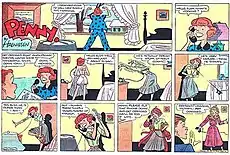Penny (comic strip)
Penny was a comic strip about a teenage girl by Harry Haenigsen which maintained its popularity for almost three decades. It was distributed by the New York Herald Tribune Syndicate from June 27, 1943 to October 25, 1970.[1]
| Penny | |
|---|---|
 Harry Haenigsen's Penny (January 21, 1951). To see this image at full resolution, go to I Love Comix Archive. | |
| Author(s) | Harry Haenigsen Bill Hoest (1965–c. 1968) |
| Current status/schedule | Concluded Daily & Sunday strip |
| Launch date | June 27, 1943 |
| End date | October 25, 1970 |
| Syndicate(s) | New York Herald Tribune Syndicate |
| Genre(s) | Teens, Humor |
Publication history
Penny began because Helen Rogers Reid, the wife of the New York Herald Tribune publisher Ogden Mills Reid, wanted to see a girl as the central character of a new comic strip.[2]
Haenigsen had been doing a strip about a teenage boy, Our Bill (1939-1963), when he launched Penny as a Sunday strip on June 27, 1943.[1] A daily strip debuted September 3, 1945.[1]
The prolific cartoonist Bill Hoest was Haenigsen's assistant on Penny. After an injury from a 1965 traffic accident kept Haenigsen away from the drawing board, Hoest took over most of the work, although Haenigsen still supervised and signed each Penny strip.
In 1968, Hoest left to start his own strip, The Lockhorns, for the Chicago Tribune New York News Syndicate. Haenigsen chose to end Penny in 1970 and retired.
Characters and story
Comics historian Don Markstein described the title character and her confused parents:
Penelope Mildred Pringle had Katharine Hepburn's cheekbones and Dick Tracy's jawline. She also took after them in personality, never gawky or shy, or for that matter, less than totally confident and self-assured. She had a best friend, Judy, but no long-term, steady boyfriend — still, she never had a problem getting dates. Her parents, Roger and Mae Pringle, were utterly mystified by her, but coped reasonably well. Inevitably, the strip was full of teenage slang, starting with that of the bobbysoxer era but moving with the times. Haenigsen (who was 43 when it started, by the way) kept up to date by hanging out at soda fountains in Lambertville, New Jersey, where he lived and worked. He also had a trick to keep it sounding current—he'd occasionally make up his own expressions. That way he not only avoided sounding quaint—there was also a chance the reader may figure that if he'd never heard it before, it must be the newest of the new. Penny was drawn in a deceptively simple, yet highly distinctive style, anticipating the uncluttered look found in such 1950s strips as Peanuts, Miss Peach and Hi and Lois.[3]
Reception
In 1947, Nancy Blair of Lambertville, New Jersey was the winner in a Penny look-alike contest staged by the New Hope Recreation Center in New Hope, Pennsylvania.[4]
In 1955, Vladimir Nabokov wrote the following description of Penny into his novel Lolita: "Her eyes would follow the adventures of her favorite strip characters; there was one well-drawn sloppy bobby-soxer with high cheekbones and angular gestures, that I was not above enjoying myself."[5]
References
- Holtz, Allan (2012). American Newspaper Comics: An Encyclopedic Reference Guide. Ann Arbor: The University of Michigan Press. p. 306. ISBN 9780472117567.
- Reynolds, Moira Davison. Comic Strip Artists in American Newspapers, 1945-1980. McFarland, 2003.
- Markstein, Don. Toonopedia: Penny
- "Most Like Penny", Nashua Telegraph (Nashua, New Hampshire), August 13, 1947.
- Nabokov, Vladimir. Lolita.